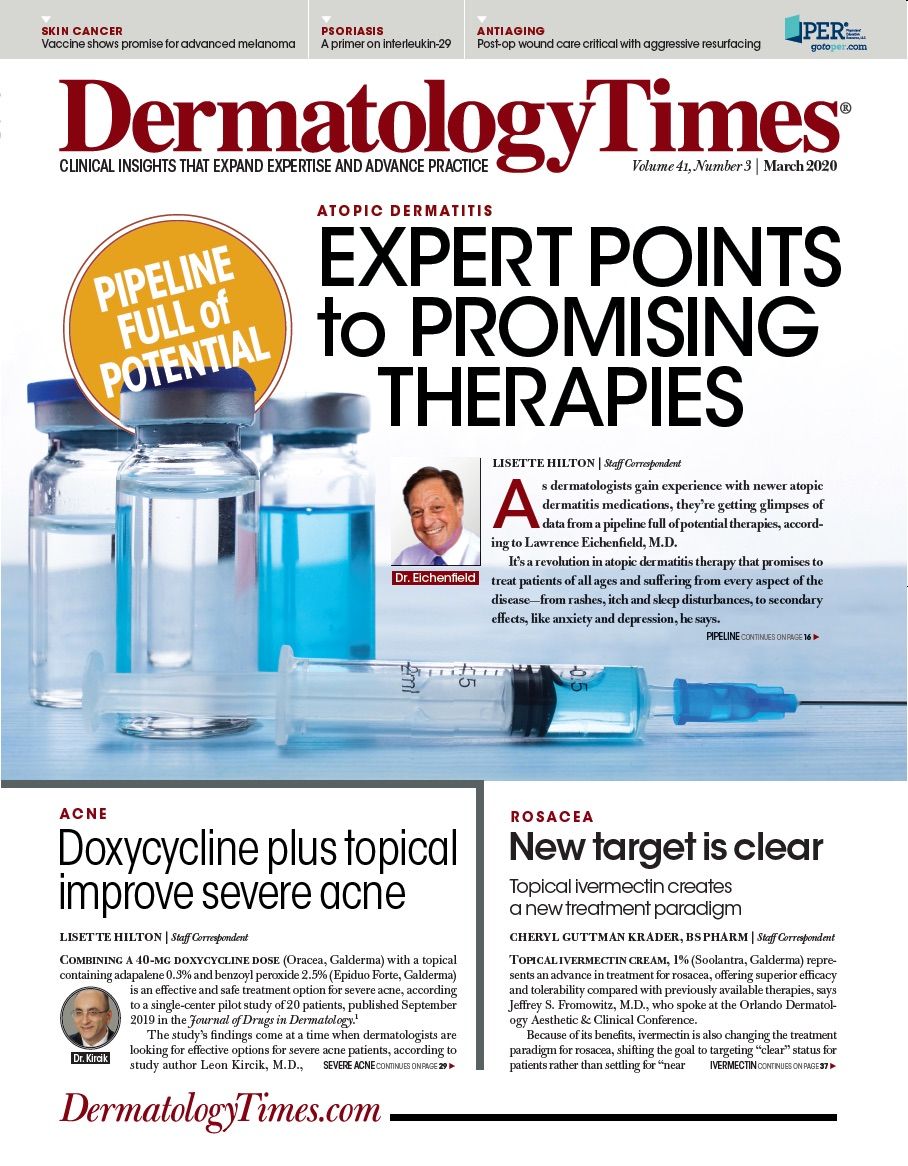- Case-Based Roundtable
- General Dermatology
- Eczema
- Chronic Hand Eczema
- Alopecia
- Aesthetics
- Vitiligo
- COVID-19
- Actinic Keratosis
- Precision Medicine and Biologics
- Rare Disease
- Wound Care
- Rosacea
- Psoriasis
- Psoriatic Arthritis
- Atopic Dermatitis
- Melasma
- NP and PA
- Skin Cancer
- Hidradenitis Suppurativa
- Drug Watch
- Pigmentary Disorders
- Acne
- Pediatric Dermatology
- Practice Management
- Prurigo Nodularis
- Buy-and-Bill
Publication
Article
Dermatology Times
A basis for standardizing care for patients with atopic dermatitis
Author(s):
As one of the most common dermatological conditions of childhood, atopic dermatitis affects between 10% and 20% of pediatric patients. Knowing how to most effectively treat these individuals is critical to ensuring the best possible outcomes. However, no clear framework exists to guide dermatologists and other pediatric providers on the optimal therapeutic methods.
To ensure patients receive standardized care, a team led by Adrian Pona, M.D., a dermatologist with Wake Forest University School of Medicine, investigated not only which providers most frequently treat children with atopic dermatitis, but which medications they most commonly prescribe, as well. They published their findings in October in a study in the Journal of Drugs in Dermatology.1
“The most important thing to understand is that we have guidelines for atopic dermatitis,” he says. “We’ve got guidelines on how to manage it appropriately, and we want to see if healthcare providers are adhering to those guidelines.”
Following treatment recommendations is critical, he says, because relapse and treatment failure rates for atopic dermatitis are high, frequently leading children and their families to suffer bodily discomfort, as well as psychological and financial detriment. And, in many cases, this condition can continue into adulthood, making long-term successful management even more vital.
Examining options
To determine who treats these patients most often, Dr. Pona’s team examined 10.4 million ambulatory medical records from the National Ambulatory Medical Care Survey from 2006 to 2015. According to the records, male and female patients sought atopic dermatitis treatment equally. White children accounted for approximately 71% of patients even though the condition proportionately affected African-American and Asian-American children more, five out of every 1,000 and seven out of every 1,000, respectively.
The records also revealed children with atopic dermatitis receive treatment from a variety of providers. While pediatricians are the most common physician, seeing 31% of cases, dermatologists address 27% of cases, and family physicians see 11% of these patients. Other providers, including emergency room doctors, urgent care physicians, nurse practitioners, and physician assistants, account for the remaining 31% of cases.
Based on study results, pediatricians are the specialists that see the most atopic dermatitis cases, but dermatologists are the specialists that see the most such cases per physician.
This data also underscores the importance of all providers in the treatment and management of atopic dermatitis. The onus of providing therapy doesn’t just fall to the dermatologist, he says.
“We need to know who is seeing these patients so we can be sure they’re adhering to dermatology guidelines or that they’re adhering to the American Academy of Pediatrics guidelines,” he says. “Are we all equally prescribing the same medication? For example, are primary care and family physicians also prescribing the same things as dermatologists?”
Commonly used medications
According to the study results, topical corticosteroids are the most common medication class recommended for children with atopic dermatitis, and dermatologists are the most likely provider to prescribe the most potent of these medications, Dr. Pona says. Specifically, providers prescribe triamcinolone as their first-line drug, suggesting it in 25% of office visits. Most frequently, it is prescribed for patients between age 2 and age 7, as well as over age 18, emerging as an initial therapy in 9% and 7% of cases, respectively.
Hydrocortisone is the second most commonly prescribed topical corticosteroid at 19% , and it is most often recommended for children under one year and between age 8 and age 18. Its lower potency makes it an attractive treatment option for this age group. Providers can also turn to several similar medications. For example, desonide is prescribed in 6% of patients, clobetasol in 4%, fluocinolone in 2%, and desoximetasone in 1%.
Alongside topical corticosteroids, Dr. Pona says, providers also employ moisturizers as an effective atopic dermatitis treatment. Study results revealed that physicians recommend pimecrolimus cream during 6% of office visits. It’s important to note, though, he adds, that because moisturizers are not considered drugs, no definitive instructions for prescribing patterns for healthcare providers exists.
Additionally, Dr. Pona cautions providers about the use of second-generation antihistamines, including cetirizine, to treat atopic dermatitis. Although these drugs were the second most commonly prescribed medications for this patient population, using them to manage the condition is not recommended. There’s currently little evidence to support their efficacy, he says.
Ultimately, Dr. Pona hopes the findings from this study can be used to guide further atopic dermatitis treatment.
“This information acts as a reference to what the nature of managing atopic dermatitis will be in the future,” he says. “It’s a reference that we will use to manage and follow the guidelines for our future patients. And, it will help us know - in the next decade - if they’re still adhering to the recommended guidelines.”
Disclosures:
Researchers examine which providers most frequently treat children and with which medications with hope that insight offers guidance for treatment.
References:
1 Pona A, Cline A, Kolli S, Feldman SF, Fleischer AFJ. Prescribing Patterns for Atopic Dermatitis in the United States. J Drugs Dermatol. 2019;18(10):987-990.







